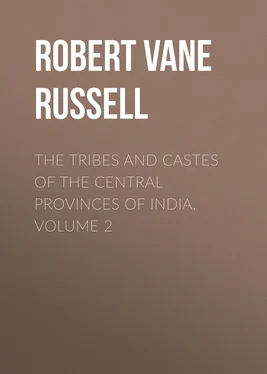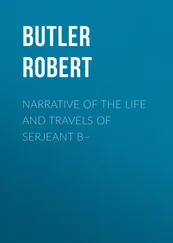Robert Vane Russell - The Tribes and Castes of the Central Provinces of India, Volume 2
Здесь есть возможность читать онлайн «Robert Vane Russell - The Tribes and Castes of the Central Provinces of India, Volume 2» — ознакомительный отрывок электронной книги совершенно бесплатно, а после прочтения отрывка купить полную версию. В некоторых случаях можно слушать аудио, скачать через торрент в формате fb2 и присутствует краткое содержание. Жанр: foreign_prose, История, foreign_edu, foreign_antique, на английском языке. Описание произведения, (предисловие) а так же отзывы посетителей доступны на портале библиотеки ЛибКат.
- Название:The Tribes and Castes of the Central Provinces of India, Volume 2
- Автор:
- Жанр:
- Год:неизвестен
- ISBN:нет данных
- Рейтинг книги:4 / 5. Голосов: 1
-
Избранное:Добавить в избранное
- Отзывы:
-
Ваша оценка:
- 80
- 1
- 2
- 3
- 4
- 5
The Tribes and Castes of the Central Provinces of India, Volume 2: краткое содержание, описание и аннотация
Предлагаем к чтению аннотацию, описание, краткое содержание или предисловие (зависит от того, что написал сам автор книги «The Tribes and Castes of the Central Provinces of India, Volume 2»). Если вы не нашли необходимую информацию о книге — напишите в комментариях, мы постараемся отыскать её.
The Tribes and Castes of the Central Provinces of India, Volume 2 — читать онлайн ознакомительный отрывок
Ниже представлен текст книги, разбитый по страницам. Система сохранения места последней прочитанной страницы, позволяет с удобством читать онлайн бесплатно книгу «The Tribes and Castes of the Central Provinces of India, Volume 2», без необходимости каждый раз заново искать на чём Вы остановились. Поставьте закладку, и сможете в любой момент перейти на страницу, на которой закончили чтение.
Интервал:
Закладка:
7. The Dauwa or wet-nurse Ahīrs. Fosterage.
The Dauwa or wet-nurse Ahīrs are descended from the illegitimate offspring of Bundela Rājpūt fathers by Ahīr mothers who were employed in this capacity in their families. An Ahīr woman kept by a Bundela was known as Pardwārin, or one coming from another house. This is not considered a disgraceful origin; though the Dauwa Ahīrs are not recognised by the Ahīrs proper, they form a separate section of the caste, and Brāhmans will take water from them. The children of such mothers stood in the relation of foster-brothers to the Rājpūts, whom their mothers had nursed. The giving of milk, in accordance with the common primitive belief in the virtue attaching to an action in itself, was held to constitute a relation of quasi-maternity between the nurse and infant, and hence of fraternity between her own children and her foster-children. The former were called Dhai-bhais or foster-brothers by the Rājpūts; they were often given permanent grants of land and employed on confidential missions, as for the arrangement of marriages. The minister of a Rāja of Karauli was his Dauwa or foster-father, the husband of his nurse. Similarly, Colonel Tod says that the Dhai-bhai or foster-brother of the Rāja of Boondi, commandant of the fortress of Tanagarh, was, like all his class, devotion personified. 25 25 Rājasthān , ii. p. 639.
A parallel instance of the tie of foster-kinship occurs in the case of the foster-brothers of Conachar or Hector in The Fair Maid of Perth . Thus the position of foster-brother of a Rājpūt was an honourable one, even though the child might be illegitimate. Ahīr women were often employed as wet-nurses, because domestic service was a profession in which they commonly engaged. Owing to the comparatively humble origin of a large proportion of them they did not object to menial service, while the purity of their caste made it possible to use them for the supply of water and food. In Bengal the Uriya Ahīrs were a common class of servants in European houses.
The Gaolis or milkmen appear to form a distinct branch of the caste with subcastes of their own. Among them are the Nāndvans, common to the Ahīrs, the Mālwi from Mālwa and the Rāghuvansi, called after the Rājpūt clan of that name. The Rānyas take their designation from rān , forest, like the Jhādia Rāwats.
8. Exogamy.
The caste have exogamous sections, which are of the usual low-caste type, with titular or totemistic names. Those of the Chhattīsgarhi Rāwats are generally named after animals. A curious name among the Mahākul Ahīrs is Mathānkāta, or one who bit his mother’s nipples. The marriage of persons belonging to the same section and of first cousins is prohibited. A man may marry his wife’s younger sister while his wife is living, but not her elder sister. The practice of exchanging girls between families is permissible.
9. Marriage customs.
As a rule, girls may be married before or after puberty, but the Golkars of Chānda insist on infant marriage, and fine the parents if an unmarried girl becomes adolescent. On the other hand, the Kaonra Ahīrs of Mandla make a practice of not getting a girl married till the signs of puberty have appeared. It is said that in Mandla if an unmarried girl becomes pregnant by a man of the caste the panchāyat give her to him and fine him Rs. 20 or 30, which they appropriate themselves, giving nothing to the father. If an Ahīr girl is seduced by an outsider, she is made over to him, and a fine of Rs. 40 or 50 is exacted from him if possible. This is paid to the girl’s father, who has to spend it on a penalty feast to the caste. Generally, sexual offences within the community are leniently regarded. The wedding ceremony is of the type prevalent in the locality. The proposal comes from the boy’s family, and a price is usually given for the bride. The Kaonra Ahīrs of Mandla and the Jharia and Kosaria Rāwats of Chhattīsgarh employ a Brāhman only to write the lagun or paper fixing the date of the wedding, and the ceremony is conducted by the sawāsins or relatives of the parties. In Chhattīsgarh the bridegroom is dressed as a girl to be taken to the wedding. In Betūl the weddings of most Gaolis are held in Māgh (January), and that of the Rānya subcaste in the bright fortnight of Kārtik (October). At the ceremony the bride is made to stand on a small stone roller; the bridegroom then takes hold of the roller facing the bride and goes round in a circle seven times, turning the roller with him. Widow remarriage is permitted, and a widow is often expected to marry the younger brother of her deceased husband. If a bachelor wishes to marry a widow he first goes through the ceremony with a dagger or an earthen vessel. Divorce is freely permitted. In Hoshangābād a strip is torn off the clothes worn by husband and wife as a sign of their divorce. This is presumably in contrast to the knotting of the clothes of the couple together at a wedding.
10. Birth customs.
Among the Rāwats of Chhattīsgarh, when a child is shortly to be born the midwife dips her hand in oil and presses it on the wall, and it is supposed that she can tell by the way in which the oil trickles down whether the child will be a boy or a girl. If a woman is weak and ill during her pregnancy it is thought that a boy will be born, but if she is strong and healthy, a girl. A woman in advanced pregnancy is given whatever she desires to eat, and on one occasion especially delicate kinds of food are served to her, this rite being known as Sidhori. The explanation of the custom is that if the mother does not get the food she desires during pregnancy the child will long for it all through life. If delivery is delayed, a line of men and boys is sometimes made from the door of the house to a well, and a vessel is then passed from hand to hand from the house, filled with water, and back again. Thus the water, having acquired the quality of speed during its rapid transit, will communicate this to the woman and cause her quick delivery. Or they take some of the clay left unmoulded on the potter’s wheel and give it her to drink in water; the explanation of this is exactly similar, the earth having acquired the quality of swiftness by the rapid transit on the wheel. If three boys or three girls have been born to a woman, they think that the fourth should be of the same sex, in order to make up two pairs. A boy or girl born after three of the opposite sex is called Titra or Titri, and is considered very unlucky. To avert this misfortune they cover the child with a basket, kindle a fire of grass all round it, and smash a brass pot on the floor. Then they say that the baby is the fifth and not the fourth child, and the evil is thus removed. When one woman gives birth to a male and another to a female child in the same quarter of a village on the same day and they are attended by the same midwife, it is thought that the boy child will fall ill from the contagion of the girl child communicated through the midwife. To avoid this, on the following Sunday the child’s maternal uncle makes a banghy, which is carried across the shoulders like a large pair of scales, and weighs the child in it against cowdung. He then takes the banghy and deposits it at cross-roads outside the village. The father cannot see either the child or its mother till after the Chathi or sixth-day ceremony of purification, when the mother is bathed and dressed in clean clothes, the males of the family are shaved, all their clothes are washed, and the house is whitewashed; the child is also named on this day. The mother cannot go out of doors until after the Bārhi or twelfth-day ceremony. If a child is born at an unlucky astrological period its ears are pierced in the fifth month after birth as a means of protection.
Читать дальшеИнтервал:
Закладка:
Похожие книги на «The Tribes and Castes of the Central Provinces of India, Volume 2»
Представляем Вашему вниманию похожие книги на «The Tribes and Castes of the Central Provinces of India, Volume 2» списком для выбора. Мы отобрали схожую по названию и смыслу литературу в надежде предоставить читателям больше вариантов отыскать новые, интересные, ещё непрочитанные произведения.
Обсуждение, отзывы о книге «The Tribes and Castes of the Central Provinces of India, Volume 2» и просто собственные мнения читателей. Оставьте ваши комментарии, напишите, что Вы думаете о произведении, его смысле или главных героях. Укажите что конкретно понравилось, а что нет, и почему Вы так считаете.












